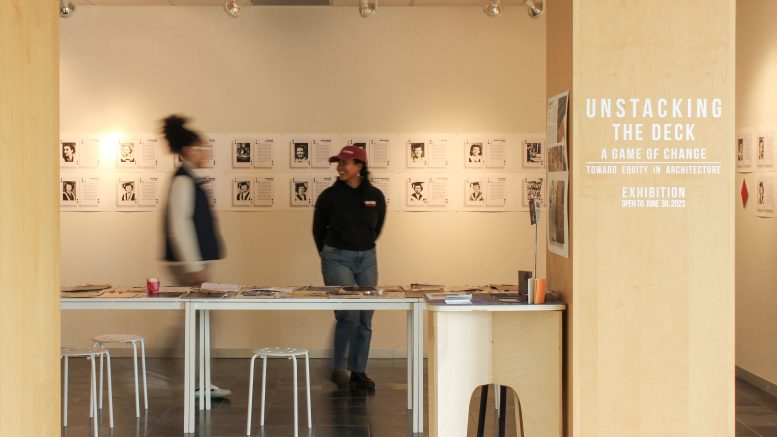Tucked away in the Dafoe library’s Icelandic Reading Room, the Unstacking the Deck exhibition honours the first women architecture graduates from the University of Manitoba and the call to move beyond binaries, beyond borders and toward Indigenous sovereignty in design. Attendees have until Sept. 15 to see the double-deck playing cards depicting photographs and biographies of influential female graduates.
The project, which was created by Lisa Landrum, associate professor and associate dean of research for the faculty of architecture at the U of M, has a long history going as far back as 2011.
Pinpointing its conception to a comment made by a student on the lack of representation of women in architecture teaching, Landrum responded by creating a lecture first. She then made a predecessor to the current deck, featuring primarily North American and European women, which was showcased at the 2019 Winnipeg Design Festival.
However, after a conversation with Marieke Gruwel, an art historian working with the Winnipeg Architecture Foundation who had done research on women in architecture in Manitoba specifically, Landrum decided she wanted to do a deck of cards celebrating and highlighting the women in her own region ― in particular, women who were first graduates from the architecture and design programs at the U of M.
“It has a long backstory but then it really got off the ground in 2021, after communicating with Marieke Gruwel at Winnipeg Architecture Foundation and then with the support of students, including the support of a creative works grant at the University of Manitoba,” Landrum said.
The struggles of women graduates isn’t where the deck stops, however.
“Gender questions are there in the cards and definitely the focus is on women graduates, but there are also the cards highlighting the work that remains to be done in diversity with international students, diversity and agency for Indigenous populations, as well as LGBTQ2S+ populations,” Landrum said.
Accessibility is another factor Landrum wanted to explore for the deck, saying at one point she had the idea of making a braille set of cards. “There’s also an ableist perspective which is so far not yet represented in this project, but could and should be,” she said.
These perspectives are things that Landrum would like to see added in the future and she welcomes collaborators to take them on.
“The fun thing about the playing card motif is it’s something that you kind of deal out and it’s a game that requires multiple players,” she said.
“If somebody would like to take this up, I would happily share an InDesign file with them and they can take it on.”
Asha Stott, a fourth-year faculty of architecture student working with Landrum through the undergraduate research award, said that at the start of researching for this project she had looked at archival pieces and one in particular from a 1974 Winnipeg Tribune article initially shocked her.
“The first line started with how the supremacy of the male has been threatened, which I think is probably not something that we would read nowadays — I hope not,” Stott said.
She said the article highlighted the progress and difference between then and now.
“Obviously we’ve made strides and broken barriers, but there’s still progress to be made and it just makes me wonder how different things might be another several decades from now.”
There’s a weight carried with these playing cards, their history and the exhibit itself, and both Landrum and Stott have expressed a desire for that to be recognized.
“I think it’s crucial for people to see themselves reflected in these professional and academic settings, because it kind of reinforces our freedom to exist, create and achieve the things we want to,” Stott said, saying the project participates in honouring history while also being aware of contemporary times.
The importance of archives and libraries being a takeaway from the exhibit was also on Landrum’s mind. “Certainly, archives, there’s an important decolonization and diversity perspective to unpacking the contents of libraries, but there is a lot of content in the archives that can help tell the untold stories of underrepresented groups if people go to archives with new questions,” she said.
Landrum said she also hopes people take away their own ideas about creative research and how research can be made accessible.
“I also hope that people will look to their own disciplines ― not just design fields, architecture, city planning, et cetera, but look to their own design fields — and ask questions about intersectional justice and diversity,” she said.
The Dr. Paul H.T. Thorkalson Gallery will feature Unstacking the Deck until Sept. 15 at the Icelandic Reading Room, 3rd floor, Elizabeth Dafoe Library, from Monday to Friday 8:30 a.m. to 4:30 p.m.



